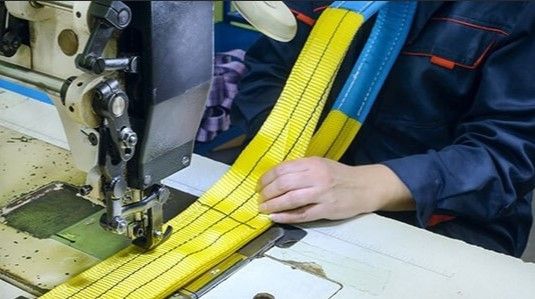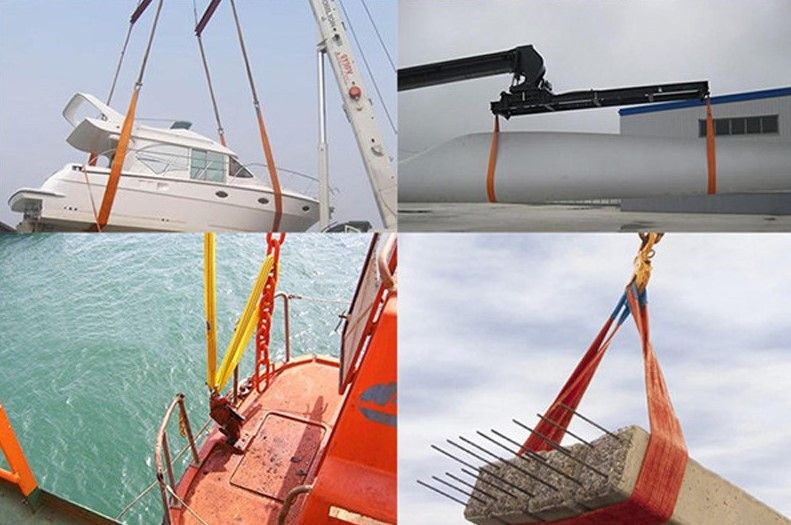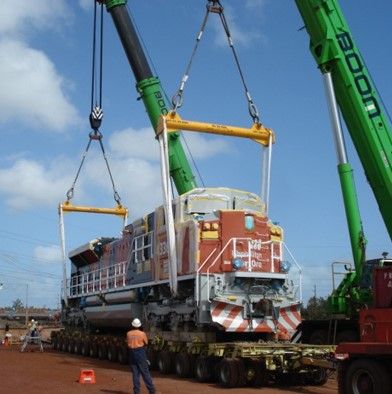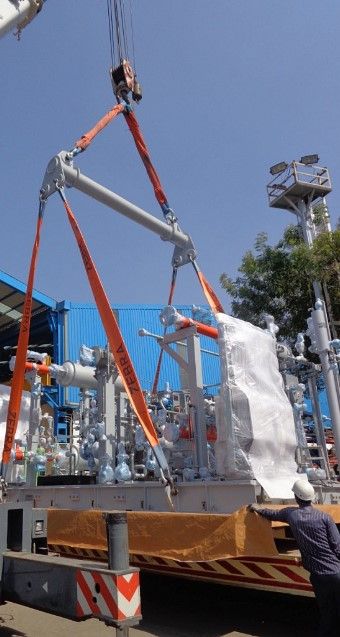1410, PARKSON, 44-60 ZHONGSHAN ROAD, QINGDAO, CHINA
1. Conditions and circumstances where extra attention must be taken into consideration when planning to use flat polyester webbing slings.
Polyester has good resistance to many acids, but is damaged by alkalis. When repeated lifting operations take place in a chemical environment, harmful concentrations may occur as a result of evaporation. Contaminated webbing slings shall be taken out of service then well-washed, using clean water and examined by a competent person. Certain types of steel end fittings for slings, can become susceptible to hydrogen embrittlement, when they are in contact with acids or acid fumes. Before sling use in any chemical environment, please contact your supplier or the manufacturer for technical and safety advice. Polyester Webbing slings can normally be used and stored in temperatures between -40°C and100°C. (Caution: These values may change in a chemical environment) Slings used in cold or icy water, or snow conditions can lead to ice crystals forming in the sling material. This can result in internal damage to the sling. In addition, the sling becomes stiff and slippery, leading to increased risks in service. Drying of a wet sling should take place at normal room temperature or ambient temperature. (Max 40° C) Polyester Webbing slings have good resistance to UV radiation during normal operation. Storage should take place where the sling is not exposed to direct sunlight or UV radiation from other sources.

2. Selection and use of flat webbing slings of polyester.
When you select and specify flat webbing slings of polyester, consider:
Required working load limit (WLL), mode factor for use (overloading is not permitted), type of load
The method of use, together with the weight, size and shape of the load, working environment and other properties of load such as stiffness, etc., will all affect the correct selection.
The selected sling must be strong enough and of correct length for the actual mode of use. When more than one sling is used to lift a single load, all slings should be identical (in most cases). The environment or load shall not be of a type that will affect polyester webbing slings in a negative manner. The connection of the sling to load and lifting equipment shall be evaluated. Consideration should be given to end fittings and lifting equipment, which shall be compatible with the webbing sling. When selecting end fittings, consider the use of components especially designed for use in combination with polyester slings, which are available in the market. When a sling with eye terminations is in use, consideration must be taken to ensure that the internal angle of the sling eye does not exceed 20°. When connecting a webbing sling to a lifting device/hook, the shape of the hook be of a type that allows correct and good contact to the sling, without deformation of the sling, or point load at any part of the sling width. Wide slings can be affected by the inside radius of the hook as a result of curvature of the hook.

Plan the lifting operation before action. Slinging, lifting and lowering: Good slinging practice shall be followed.
Webbing slings shall be located and connected in proper positions in a safe and correct way. The sling shall be protected from sharp and uneven edges, friction and other damage, from both the load and lifting device. Protection sleeves and other types of protection shall be used when required, and be positioned correctly. Slings shall be attached in a way that ensures the load will be carried by their full width. Slings shall never be used when twisted or knotted. Loadbearing seams and stitches must not be placed over hooks or other connection points. Harm or damage to the marking / label shall be avoided.
Lifting in good balance
3. Safety of persons must be ensured.
Before the lifting operation takes place: Personnel not involved in the lifting operation, but within the danger zone, should be warned and if necessary, evacuated from the area. Keep hands and other body parts away from the sling, to avoid injury when slack is taken up. Personnel should never position themselves between the load and any close obstacle or wall during the lifting operation.

A trial lift should be made; the load should be carefully raised just a little to ensure that it will take the desired position in a safe way. This is particularly important with basket hitch or other applications where friction between sling and load is of importance. Attention regarding the tendencies of tilting and sliding must be taken, and retrial with repositioning of slings, must be done until the stability is ensured.
Care must be taken to keep full control during the full lifting process, to avoid collisions or other uncontrolled movements. Avoid snatch or shock loading, as these will give increased load on the slings and lead to bad control of the lifting process. Do not drag the load or sling itself over ground or rough surfaces.
• The load shall be lowered in the same well controlled way as it was lifted. Do not place the sling in a way that it will be trapped under the load after lifting and lowering. Avoid situations where slings must be dragged free from a load resting on it

4. Inspection of flat webbing slings.
Inspection before first use:
Check that WLL and other characteristics of the sling correspond with the lifting application.
Check that manufacturers certificate is available, showing correct traceability between sling and certificate. (Material number and batch number of the sling, shall be covered by the certificate).
Inspection before each use:
Inspect the sling for visible defects and that labels and marking are in good condition. Make sure that WLL and other data is suitable for the planned use. If any doubts exist regarding the condition of the sling, remove it from service, for examination by a competent person.
In-service inspections:
Inspect the sling for visible defects and ensure that all labels and markings are in good condition. If any doubts exist, remove the sling from service, for examination by a competent person.

Signs of defects or damage can be:
Local abrasion, or cut from sharp edge or similar.
Damage at seam.
Damage at eye
Cuts or damage at edge.
Flaking of the surface which may be rubbed off. (Chemical attack)
Glazed or melted surface (heat or friction damage)
Deformed or otherwise damaged fittings
Periodic inspection:
Periods for inspection should be determined by both the working environment and frequency of sling use. Slings shall be examined by a competent person, at least once a year, or subject to the local statutory regulations.
Records from examination shall be maintained, with full identity of the sling. If any doubts exist, the sling must be removed from service and examined by a competent person.
Repair
Repairs to slings can only be by carried out specialists. Never try to repair a sling by yourself.
Storage:
After use, slings must be inspected. Damaged slings shall be repaired or replaced, and undamaged slings must be stored in a dry place, protected from harmful environments. (e.g. chemicals and strong UV radiation)
Wet slings must be carefully dried, before storage.